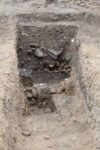 The tomb of the Nicholas Rolin, chancellor of the powerful dukedom of Burgundy in the 15th century, may have been discovered at the site of the church of Notre-Dame-du-Châtel in Autun. The church itself was a casualty of the French Revolution, and Nicholas’ remains were assumed to be lost, if not destroyed. A preventive excavation of the site, now the Place Saint-Louis, in advance of expansion of the Rolin Museum into the old prison and courthouse that border the square unearthed the jumbled bones of at least eight individuals in what had been the crypt of the church. One key artifact was found in the mix: a spur like the one Rolin had specified as part of his burial outfit.
The tomb of the Nicholas Rolin, chancellor of the powerful dukedom of Burgundy in the 15th century, may have been discovered at the site of the church of Notre-Dame-du-Châtel in Autun. The church itself was a casualty of the French Revolution, and Nicholas’ remains were assumed to be lost, if not destroyed. A preventive excavation of the site, now the Place Saint-Louis, in advance of expansion of the Rolin Museum into the old prison and courthouse that border the square unearthed the jumbled bones of at least eight individuals in what had been the crypt of the church. One key artifact was found in the mix: a spur like the one Rolin had specified as part of his burial outfit.
“Fairly consistent clues allow us to confirm that this is indeed Nicolas Rolin’s cellar,” says Yannick Labaune. The certainties of archaeologists are based in particular on the presence of a spur that belonged to the illustrious chancellor of the 15th century. The presence of this spur appears in the testimonies and descriptions of the burial of Nicolas Rolin. “We also know that he was buried with a sword and a dagger, but archaeologists have not found them,” said Vincent Chauvet, Mayor of Autun. And to formulate the hypothesis that these two pieces were stolen during a looting during the dismantling of Notre Dame du Chatel.
Studies will continue in the laboratory in order to carry out DNA analyzes as well as Carbon 14 dating, in particular on the eight skulls found in the tomb. This work will provide more details and above all confirm, even if there is little doubt, that the tomb is indeed that of Nicolas Rolin. The scene will be photographed from different points of view in order to use the technique of photogrammetry and to preserve 3D images.
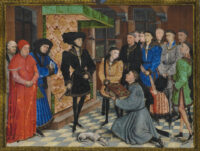 Born of modest bourgeois parents in Autun in 1376, Nicholas Rolin became and lawyer and vaulted over the restrictive social hierarchies of the Burgundian court to become chancellor to Philip the Good, Duke of Burgundy. He served 40 years in the role and amassed a huge amount of wealth, titles, properties and honors on the way. He dispensed as well as he amassed; spending heavily on luxuries, the showier the better, artworks and charitable endeavors. He was a major patron of the Church, erecting churches, endowing new religious orders.
Born of modest bourgeois parents in Autun in 1376, Nicholas Rolin became and lawyer and vaulted over the restrictive social hierarchies of the Burgundian court to become chancellor to Philip the Good, Duke of Burgundy. He served 40 years in the role and amassed a huge amount of wealth, titles, properties and honors on the way. He dispensed as well as he amassed; spending heavily on luxuries, the showier the better, artworks and charitable endeavors. He was a major patron of the Church, erecting churches, endowing new religious orders.
Notre-Dame-du-Châtel was a small parish church, not the city’s glamorous cathedral, but it was personally important to Nicholas. He was baptized there and his maternal family had donated an altar in the church’s side chapel of St. Sebastian. The church was in poor condition by the 1420s and Rolin used his money and influence to shore it back up, starting with a reconstruction of the family chapel and in 1431, the reconstruction of the entire church. He then pulled strings with the Pope to have the church’s status promoted from parish to collegiate (administered by a college of canons).
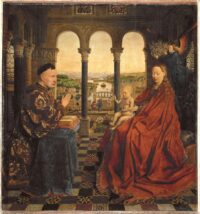 Around 1435, Nicholas Rolin commissioned a portrait from no lesser a master than Jan van Eyck, court painter of Philip the Good, to adorn the family chapel. He is depicted praying in front of the Virgin Mary and the infant Christ as the latter blesses him. It connects Rolin’s wealth (the opulent clothing and surroundings, vineyards in the background) and political success (the Treaty of Arras ending the Hundred Years’ War had just been signed with terms very much to Burgundy’s advantage) to his religious devotion and the direct favor of God.
Around 1435, Nicholas Rolin commissioned a portrait from no lesser a master than Jan van Eyck, court painter of Philip the Good, to adorn the family chapel. He is depicted praying in front of the Virgin Mary and the infant Christ as the latter blesses him. It connects Rolin’s wealth (the opulent clothing and surroundings, vineyards in the background) and political success (the Treaty of Arras ending the Hundred Years’ War had just been signed with terms very much to Burgundy’s advantage) to his religious devotion and the direct favor of God.
(Naughty interlude: in 1431, the same year he funded the reconstruction of Notre-Dame-du-Châtel in Autun, Nicholas Rolin founded a Celestine convent in Avignon with his first son Jean, Bishop of Autun and future Cardinal, as co-founder. Jean, who shared his father’s thirst for all the luxuries the profane world had to offer, impregnated one of the nuns in that convent. Their son, also named Jean, would follow in his father’s and grandfather’s footsteps. A cleric, he served ambassador to the Holy See and to the court of King Charles VIII, the latter of whom legitimized his birth and made him his councilor. Jean’s last appointment was as Bishop of Autun, just like dear old dad.)
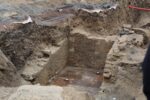 Nicholas Rolin died in 1462. He left detailed instructions for his funeral from the rites — three days of mourning “in public view of everyone” — down to the clothes he wanted to ear — white shirt, doublet, a velvet robe with a hood at the neck, a hat with a gold brooch pinned to the front, a sword on his side, a dagger on his other side, new shoes on his feet and gold spurs on his heels.
Nicholas Rolin died in 1462. He left detailed instructions for his funeral from the rites — three days of mourning “in public view of everyone” — down to the clothes he wanted to ear — white shirt, doublet, a velvet robe with a hood at the neck, a hat with a gold brooch pinned to the front, a sword on his side, a dagger on his other side, new shoes on his feet and gold spurs on his heels.
The church was demolished in 1793 and its building materials reused. The Van Eyck portrait was saved, thankfully, and eventually made its way to Louvre in 1805, despite numerous petitions from Autun citizens to Napoleon’s brother Lucien (who had gone to school in Autun) and Talleyrand (the former Bishop of Autun) asking for the masterpiece to be returned to the city. The oil-on-panel painting was intact, but it was missing its original frame which had borne Van Eyck’s signature and the date. The people buried inside the church, including Nicholas Rolin and his family, were given far less consideration. The burials were looted for any valuables and the bones discarded.
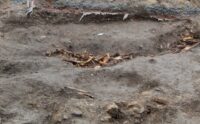 The bones that have been discovered at the church site will now be analyzed in the hope that Rolin’s remains might be identified. There’s no way of knowing right now whether his bones are even in the mix. Lots of people were buried in the church over the centuries, and the revolutionaries could just as easily have destroyed or tossed out Nicholas’ remains. The spur, which stylistically dates to the 15th century, is really the only link to him, and that’s tenuous because surely he was not the only man to be buried wearing spurs.
The bones that have been discovered at the church site will now be analyzed in the hope that Rolin’s remains might be identified. There’s no way of knowing right now whether his bones are even in the mix. Lots of people were buried in the church over the centuries, and the revolutionaries could just as easily have destroyed or tossed out Nicholas’ remains. The spur, which stylistically dates to the 15th century, is really the only link to him, and that’s tenuous because surely he was not the only man to be buried wearing spurs.
What a Mass! (and a mess too) ..and.. what has happened to the spur?
The Order of the Golden Fleece is a Catholic order of chivalry (still in existence) founded in 1430 by Philip the Good, to celebrate his marriage to Isabella of Portugal. Currently, two branches of the order exist, namely the Spanish and the Austrian Fleece.
In the Rogier van der Weyden miniature, all the people on the right –with the exception of the chronicle presenter and the dog– seem to be Golden Fleece knights. Fleece knights were e.g. Napoleon Bonaparte and the Duke of Wellington, cf.:
upload.wikimedia.org/wikipedia/commons/8/83/Sir_Arthur_Wellesley%2C_1st_Duke_of_Wellington.png
The ‘Order of the Dragon’ (Societas Draconistarum, “Club of the Dragonists”), on the other hand, was a chivalric order for selected higher nobility and monarchs, founded in 1408 by Sigismund of Luxembourg, King of Hungary.
The most interesting “Dragonists” are Oswald Wolkenstein and Vlad II Dracul, the dad of “Dracula”, Vlad the Impaler.
:hattip:
—————–
Here, the lawyer and late expert of medieval music E. Kummer sings one of Oswald’s songs from 1422:
youtu.be/HWo3kPp8IJo?t=183
—————–
“Shrovetide-Song / Es nahet gen der Vasenacht“:
It’s getting near Shrove Tuesday,
so let us rejoice and be merry.
You pair off in twos,
just like sweet little doves.
But I have chosen for
my fair companion a crutch,
which my lover gave to me
instead of a loving caress.
–Refrain–:
And I hug the crutch
close to me,
so it nestles tenderly under my arm;
I give it a firm squeeze
and make it squeal.
How could the Shrovetide be more
completely spoiled for me?
Pah! Now stop your wailing!
Since wild birds are
now paired off in peaceful harmony,
why should ‘tame’ young people
be slow to welcome this happy time
by kissing and hugging a beautiful woman?
Come on, let’s see how you taste!
Enjoy your young bodies, away from prying eyes
and free of cares!
Shrovetide and Maytime,
they play on the same pipe!
Everything that has been hidden away all the year now
comes out into the light of day.
But my lady stored away her treachery
for a deceitful invitation
in the autumn. A curse on that pilgrimage of hers
Since I am left with a limp.
NB. the text says “gold spurs”. That is distinctive, identifying feature, I’m sure!
Also note that the faces in the first portrait are surely portraits, for the most part. Somewhat unusual, I suspect, though perhaps not rare at this lateish time..
OMG — on the 2nd painting, the Madonna of Chancellor Rolin by Jan van Eyck, there is what might be tiny allusions to the seven deadly sins, and as far as Lust is concerned, there are, i.e. under the basis of the left black column …cr.. :ohnoes: crushed little pl*yboy cartoon rabbits!!!
———–
cf.: upload.wikimedia.org/wikipedia/commons/b/b9/Madonna_of_Chancellor_Rolin_(detail).jpg
———–
Besides, Nick’s portrait in the first painting does indeed match the one on Jan van Eyck’s.
OK, let me get this straight. They publish an article about a famous person being identified by the wonderful discovery of a very distinctive spur but fail to publish a picture of said spur. Am I missing something?
P. Shriver and Friends,
No doubt that there are serious differences between the two paintings of Rolin. Not only do several years separate these two images, but no two artists flattered their patrons in the same way.
Consider the two best-known portraits of Anthony, Bastard of Burgundy: https://en.wikipedia.org/wiki/Anthony,_bastard_of_Burgundy . The painting of Anthony holding the arrow was done by Rogier van der Weyden, probably in 1462 or 1463, after Anthony won the great archery tournament at Bruges. Van der Weyden was noted for “tweaking” the features of his subjects to make his paintings more flattering. Here he emphasized Anthony’s jaw and brow.
The second portrait was by Hans Memling and was painted 5-7 years later, when age and high living were catching up with Anthony. Here we see a far less flattering portrait of a man now in his middle ages: older, fleshier, his nose and chin rendered with less “nobility”, but probably a truer image.
Van der Weyden’s court view (above, with the article) dates from around 1447. The man in green prominently shown on the right side of the composition is probably Anthony again. (Van der Weyden knew to give him separate treatment from the other knights in that clump at the back; Anthony was Philip the Good’s favorite “blow-by”, and was arms instructor and minder to his younger half-brother Charles the Bold). Doesn’t look much like either of the other two portraits, does it?
By the way, note how many of these men wear the same neck chain, including Philip and young Charles. They are Knights of the Golden Fleece, an order started by Phil in imitation of England’s Order of the Garter. That the young man in green is also wearing the chain is another indication this is Anthony.
I am fascinated by Dukes of Burgundy and their courts. They could often be pretty nasty fellows, but they always did everything with style and class!
Yours Aye,
Lord Mungo Napier, Laird of Mallard Lodge (SCA) 🦆